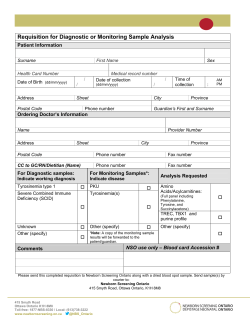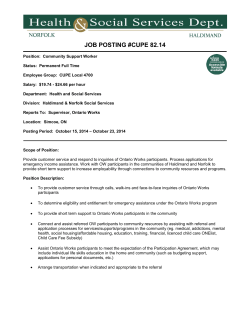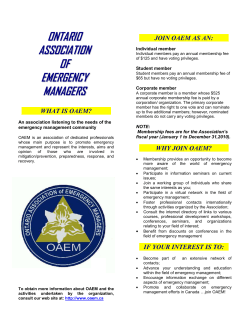
2233G-001 - Anthropology - University of Western Ontario
Anthropology/FNS 2233G/001 January-April 2015 Department of Anthropology ANTH 2233G-001 Archaeology of Ontario and the Great Lakes Course Outline Winter 2015 Class time: Wednesdays 7-10:00 pm Room location: Social Sciences 2257 Instructor: Chris Ellis Office: SSC 3409, Phone: ext. 85081 Email: cjellis@uwo.ca Office Hours: Wednesdays 6:15-6:50 pm; Thursdays 11:30AM-12:30 pm TA: Kyle Forsythe Office: TBA Email: kforsyt2@uwo.ca Office Hours: TBA Prerequisite: Anth 1020E, or Anth1025F/G and Anth 1026F/G, or Anth 2100, or FNS 1020E Anti-requisite: None COURSE CONTENT: This course provides an overview of the human history of the Great Lakes area (with a focus on southern Ontario) from ca. 14,000 years ago to A.D. 1650. The emphasis will be on the documentation and explanation of change and diversity in the archaeological record as First Nations groups coped with changing and spatially variable environmental and social milieus. COURSE MARKS: Grades will be based on: a) a mid-term exam to be held in class time on February 25th, 2015 (30%); b) a final exam to be scheduled by the registrar in the final exam period from April 11-30, 2015 (30%); and c) a course paper due in class on March 18, 2015 (40%). The final exam will only cover material after the mid-term (e.g. from March 4th to the end of the course). Generally, the exams will consist of short, written answer, definitional-type questions and longer essay questions. REQUIRED COURSE READINGS: There required readings for this course will be taken from a series of articles that summarize developments and characteristics of particular time periods or focus on specific sites or interpretative issues in more detail. The particular readings from these sources are all available on-line as pdfs via the wen or the library and are listed in the course schedule below. OTHER AVAILABLE TEXTS: Anthropology/FNS 2233G/001 January-April 2015 Although somewhat out of date, out of print, or focused outside Ontario, or were written for a more popular audience there are some textbooks, which the student may find of use and interest and which are in the stacks in the library. These include: Ontario Prehistory: An 11,000 Year Archaeological Outline, by James V. Wright, 1972, Ottawa, National Museums of Canada. A History of the Native People of Canada, Volumes I, II and III (part 1), by James V. Wright, 1995-2004, Canadian Museum of Civilization Mercury Series Paper 152, Ottawa. The Archaeology of Michigan: A Guide to the Prehistory of the Great Lakes Region, by James E. Fitting, 1970, New York, Natural History Press. Indian Life in the Upper Great Lakes, by George I. Quimby, 1960, Chicago, University of Chicago Press. The Archaeology of New York State, Revised Edition, by William A. Ritchie, 1969, New York, Natural History Press. Retrieving Michigan’s Buried Past: the Archaeology of the Great Lakes State, edited by John R. Halsey, 1999, Bloomfield Hills, Michigan, Cranbrook Institute of Science Bulletin 64. The Archaeology of Southern Ontario to A.D. 1650, edited by Chris Ellis and Neal Ferris, 1990, London Chapter, Ontario Archaeological Society, Occasional Publication No. 5. Before Ontario: The Archaeology of a Province, edited by Marit K. Munson and Susan B. Jamieson, 2013. Montreal: McGill-Queens University Press. Archaeology of Minnesota : The Prehistory of the Upper Mississippi River Region, by Guy Gibbon, 2013.Minneapolis: University of Minnesota Press. COURSE PAPER: All students are required to submit a paper dealing with some aspect/problem of Great Lakes archaeology. All paper topics must be approved by the instructor or his Teaching Assistant. Papers should be at least 10-15 pages in length (typed, double-spaced) and are due in class on March 18, 2015. These papers should be in the format for writing papers in Anthropology. This format can be obtained by consulting any recent issue of the journals American Anthropologist or American Antiquity in the library. With reference to course papers I am forced to note: “Plagiarism and Scholastic Offences: Scholastic offences are taken seriously and students are directed to read the appropriate policy, specifically, the definition of what constitutes a Scholastic Offence, at the following website: Anthropology/FNS 2233G/001 January-April 2015 http://www.uwo.ca/univsec/pdf/academic_policies/appeals/scholastic_discipline_undergrad.pdf Students must write their essays and assignments in their own words. Whenever students take an idea, or a passage from another author, they must acknowledge their debt both by using quotation marks where appropriate and by proper referencing such as footnotes or citations. Plagiarism is a major academic offense. All required papers may be subject to submission for textual similarity review to the commercial plagiarism detection software under license to the University for the detection of plagiarism. All papers submitted for such checking will be included as source documents in the reference database for the purpose of detecting plagiarism of papers subsequently submitted to the system. Use of the service is subject to the licensing agreement, currently between The University of Western Ontario and Turnitin.com (http://www.turnitin.com).” STATEMENT ON ACCESSIBILITY: Please contact the course instructor if you require material in an alternate format or if you require any other arrangements to make this course more accessible to you. Western’s commitment to Accessibility, visit: http://wss.uwo.ca/Student%20Services%20Organizational%20Units/Accessibility%20at%20Wes tern/index.html Student Development Services http://www.sdc.uwo.ca/ssd/ has staff members who specialize in assisting students with various disabilities to adjust to the university environment. These disabilities include, but are not limited to, vision, hearing and mobility impairments, learning disabilities, chronic illnesses, chronic pain, and attention deficit/hyperactivity disorders. Students who require special accommodations for disabilities should make a formal request through Student Development Services as early in the semester as possible. STUDENT SUPPORT SERVICES: A range of student services is available at: https://studentservices.uwo.ca/secure/index.cfm Other resources include Student Support Services: http://westernusc.ca/services Students who are in emotional/mental distress should refer to Mental Health@Western http://www.uwo.ca/uwocom/mentalhealth for a complete list of options about how to obtain help. COURSE OUTLINE: Days Topics and Required Readings* January 7 Introduction and Background. January 14 The Great Lakes First Citizens: Paleo-Indians. Readings: 1) C. J. Ellis and D. B. Deller (1990). Paleoindians. In The Archaeology of Southern Ontario to A.D. 1650, edited by C. J. Ellis and N. Ferris, pp. pp. 37-63. London Chapter, Ontario Archaeological Society, Occasional Publication No. 5. Available on-line at: http://anthropology.uwo.ca/cje/1990ASOPaleo-Indians.pdf Anthropology/FNS 2233G/001 January-April 2015 This book has compiled volume references. You can access the compiled references for the whole volume at this link: http://anthropology.uwo.ca/cje/1990ASOReferences.pdf 2) D. B. Deller and C. J. Ellis - 2001 - Evidence for Late PaleoIndian Ritual from the Caradoc Site (AfHj-104), Southwestern Ontario, Canada. American Antiquity 66(2): 267-284. Available online via library. January 21-28 Early and Middle Archaic. Readings: 1) C. J. Ellis, I. T. Kenyon and M. Spence (1990). The Archaic. In The Archaeology of Southern Ontario to A.D. 1650, edited by C. J. Ellis and N. Ferris, pp. 65-124. London Chapter, Ontario Archaeological Society, Occasional Publication No. 5. Read pages 65-93 only; Available online at: http://anthropology.uwo.ca/cje/1990ASOTheArchaic.pdf This book has compiled volume references. You can access the compiled references for the whole volume at this link: http://anthropology.uwo.ca/cje/1990ASOReferences.pdf 2) W. A. Lovis, R. E. Donahue and M. B. Holman (2005). LongDistance Logistic Mobility as an Organizing Principle among Northern Hunter-Gatherers: A Great Lakes Middle Holocene Settlement System. American Antiquity 70:669-693. Available online via library. February 3 Late Archaic. Readings: 1) C. J. Ellis, I. T. Kenyon and M. Spence (1990). The Archaic. In The Archaeology of Southern Ontario to A.D. 1650, edited by C. J. Ellis and N. Ferris, pp. 65-124. London Chapter, Ontario Archaeological Society, Occasional Publication No. 5. Read pages 94-124 only. Available online at: http://anthropology.uwo.ca/cje/1990ASOTheArchaic.pdf This book has compiled volume references. You can access the compiled references for the whole volume at this link: http://anthropology.uwo.ca/cje/1990ASOReferences.pdf 2) J. Conolly, J. Dillane, K. Dougherty, K. Elaschuk, K. Csenkey, T. Wagner and J. Williams (2014). Early Collective Burial Practices in a Complex Wetland Setting: An Interim Report on Mortuary Patterning, Paleodietary Analysis, Zooarchaeology, Material Culture and Radiocarbon Dates from Jacob Island (BcGo-17), Kawartha Lakes, Ontario. Canadian Journal of Archaeology 38:106–133. Available online via library. February 11 Early Woodland: Ceramics and Burial Cults. Readings: 1) N. Ferris and M. Spence (1995). The Woodland Traditions in Southern Ontario. Revista del Arqueologia (Journal of American Anthropology/FNS 2233G/001 January-April 2015 Archaeology) 9:83-122. Read pages 83-97 only. Available online at: http://anthropology.uwo.ca/faculty/ferris/FerrisandSpenceWoo dland1995.pdf 2) K. Taché (2011). New Perspectives on Meadowood Trade Items. American Antiquity 76:41-79. Available online via library. February 18 Reading Week: No Class. February 25 Mid-Term Exam. March 4-11 Middle Woodland: Burial Mounds and Social Complexity. Readings: 1) N. Ferris and M. Spence (1995). The Woodland Traditions in Southern Ontario. Revista del Arqueologia (Journal of American Archaeology) 9:83-122. Read pages 97-102 only. Available online at: http://anthropology.uwo.ca/faculty/ferris/FerrisandSpenceWoo dland1995.pdf March 18-25 Late Woodland I: Agriculture and Villages. Readings: 1) N. Ferris and M.W. Spence (1995). The Woodland Traditions in Southern Ontario. Revista del Arqueologia (Journal of American Archaeology) 9:83-122. Read pages 102-106 only. Available online at: http://anthropology.uwo.ca/faculty/ferris/FerrisandSpenceWoo dland1995.pdf 2) J.P. Hart and W.A. Lovis (2013): Reevaluating What We Know About the Histories of Maize in Northeastern North America: A Review of Current Evidence. Journal of Archaeological Research 21:175–216. Available online via library. (Note: Course papers due in class March 18th) April 1- April 8 Late Woodland II: Appearance of Historically-Known Societies. Readings: 1) N. Ferris and M.W. Spence (1995). The Woodland Traditions in Southern Ontario. Revista del Arqueologia (Journal of American Archaeology) 9:83-125. Read pages 106-125 only. Available online at: http://anthropology.uwo.ca/faculty/ferris/FerrisandSpenceWoo dland1995.pdf 2) G. Warrick (2000). The Precontact Iroquoian Occupations of Southern Ontario. Journal of World Prehistory 14(4):415-466. Available online via library.
© Copyright 2025









